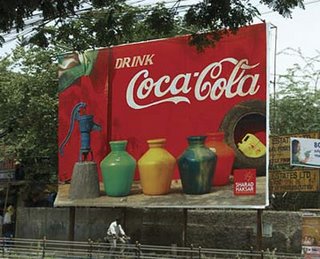Thirst

As you roll through the UP villages, the number of bore wells (the chug-chug of pumps giving them away) becomes quickly apparent. These did not exist in the late 80s when I regularly traveled in these parts. I am reminded of some data from a recent AID newsletter. In the US, 61 of 64 Coca Cola plants buy their water from the municipalities they operate in. In the US, the municipal water is available in enough volume, and is generally safe to drink, so Coca Cola has to do minimal post-processing. Not so in India; in order to keep costs low you have to operate outside the metros, and there no organization exists to deliver lakhs of liters of potable water every day. If you were to boil river-water that everyone upstream has dumped their wastes in, carbonated drinks would be as expensive as rum. So when Hindustan Coca Cola set up shop in Mehdiganj in Uttar Pradesh, it greased enough palms in babudom to be allowed to extract ground water, for free, naturally filtered through the fine sediment that makes up the acquifer. HCC estimates that it extracts 500,000 litres of ground water daily (though some in the community have claimed it is as high as 2,500,000 litres every day.) You drink it, if you order a thanda in the heartland.
All over India the water tables are falling, typically 1 or 2 feet every decade; but the water table in Mehdiganj has fallen by 18 feet in the last 6 years since HCC set up shop.
With their drinking water wells drying out, the Mehdiganj villagers are increasingly dependent on bore wells and hand pumps for their basic water needs. A hand pump costs Rs. 30,000 to buy and install. Every year, you have to drill 3 feet deeper to find water. Most workers in the village earn Rs 30 per day. 3 years' income could buy a house in the first world, that's how expensive thirst must seem to Mehdiganj.
According to my AID newsletter, in the US, Coca Cola plants use 1.86 liters of water for every liter of soda they produce; in India, since the water is free, HCC uses 3.9 liters for every liter of beverage produced.
HCC claims drought and irresponsible water use in agriculture are the reasons behind the decreasing water table. They started a press campaign to highlight their rain-water catchment projects to replenish the acquifer, and then it was apparently leaked that the goal of this was to only replenish 8% of the water coming out.
A fuller case of the villagers against HCC can be found here.You can read about all the management awards won by Coca Cola India here.


0 Comments:
Post a Comment
<< Home